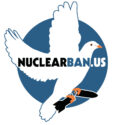By a unanimous vote of 70-0, the Mexican Senate agreed on 28th November, 2017 to ratify the Treaty on the Prohibition of Nuclear Weapons. Once Mexico’s instrument of ratification has been deposited with the United Nations, they will become the fourth country to ratify the new treaty. Thailand, Guyana and the Holy See have so far ratified the treaty. Fifty ratifications are needed for the treaty to enter into force.
The Nobel Peace Prize ceremony takes place in Oslo on 10th December. With the prize this year being awarded to ICAN, for their efforts in getting this treaty agreed at the UN earlier this year, it is very much hoped that more countries will sign and/or ratify the treaty in the next 10 days. Of the 122 countries who voted for the treaty on July 7th, only 53 countries have so far signed the treaty (with four now having ratified it). At least 146 countries are expected to sign at some point, despite enormous pressures being put on them not to sign, mainly from the United States.
There will be a special treaty signing opportunity at the United Nations in New York on Friday, 9th December, at which countries wishing to support the Nobel Peace Prize ‘moment’ can sign the treaty. Later in December, the UN General Assembly will be debating a number of resolutions urging member states to sign the treaty if they have not already done so. From 14-16 May, 2018, there will be a High Level Conference on Nuclear Disarmament at the UN in New York. This will be another key opportunity for countries to sign the treaty and/or submit their instrument of ratification to the UN. Another chance for this will come in September, 2018, on the anniversary of the initial signing ceremony, when heads of state will be at the United Nations for the annual opening of the General Assembly.







In late 1957, the Soviet Union made a second offer of a three-year moratorium without inspections, but lacking any consensus within his administration, Eisenhower rejected it. In early 1958, the discord within American circles, particularly among scientists, was made clear in hearings before the Senate Subcommittee on Nuclear Disarmament, chaired by Senator Hubert Humphrey. The hearings featured conflicting testimony from the likes of Teller and Linus Pauling, as well as from Harold Stassen, who argued that a test ban could safely be separated from broader disarmament, and AEC members, who argued that a cutoff in nuclear production should precede a test ban.
The Partial Test Ban Treaty ( PTBT ) is the abbreviated name of the 1963 Treaty Banning Nuclear Weapon Tests in the Atmosphere, in Outer Space and Under Water, which prohibited all test detonations of nuclear weapons except for those conducted underground. It is also abbreviated as the Limited Test Ban Treaty ( LTBT ) and Nuclear Test Ban Treaty ( NTBT ), though the latter may also refer to the Comprehensive Nuclear-Test-Ban Treaty (CTBT), which succeeded the PTBT for ratifying parties.
Hey there! I’ve been reading your webloɡ fоr some time now
and finallү got the bravеry tߋ go ahead and gіve үou a sһout out frօm
New Ϲaney Tx! Just wanted to say keep up the
excellent work!